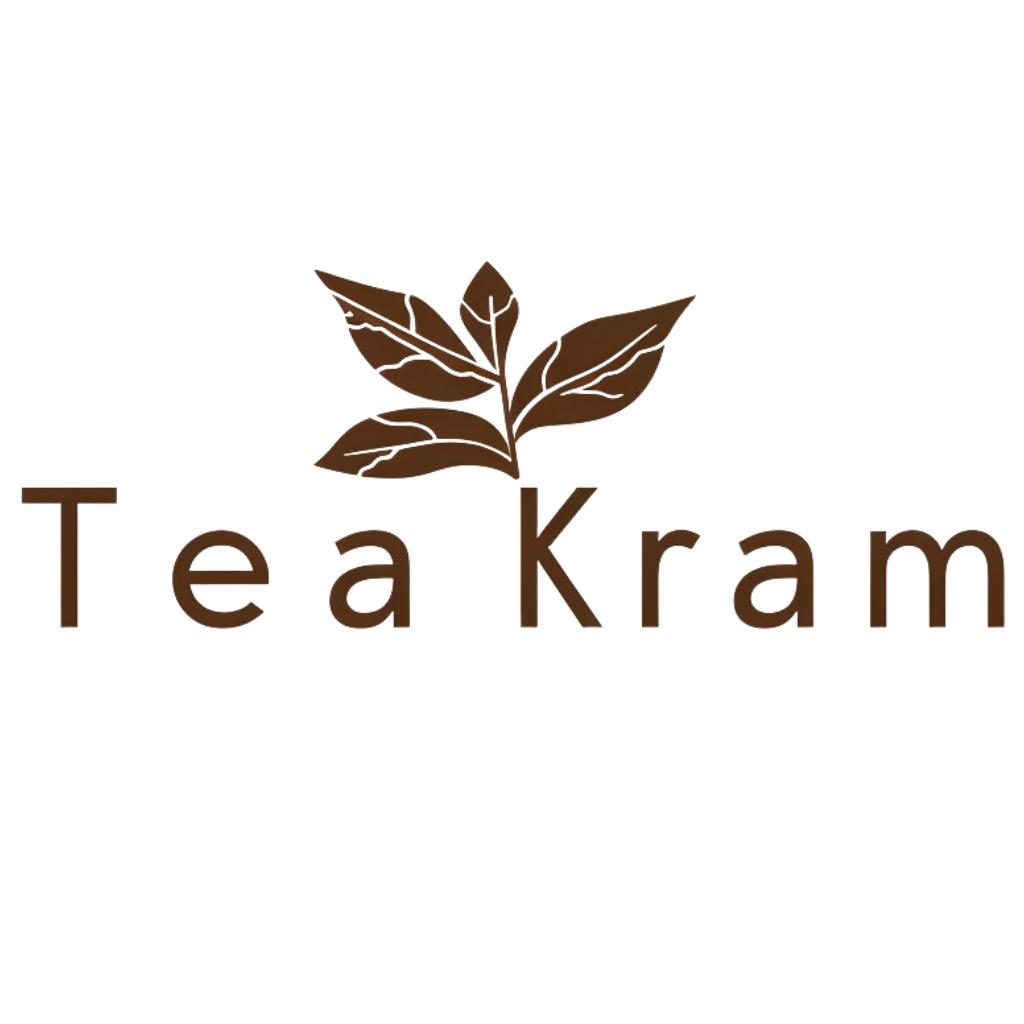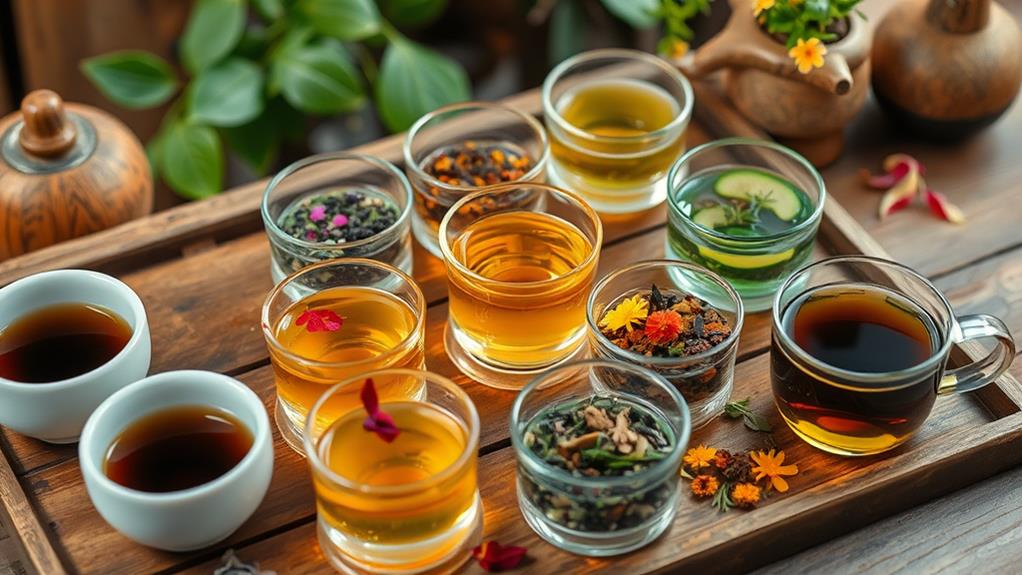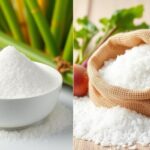Teas and tisanes are both delicious drinks, but they come from different plants. Teas are made by steeping leaves from the Camellia sinensis plant, like black or green tea. They contain caffeine and antioxidants, offering health benefits such as improved heart health. Tisanes, on the other hand, are herbal infusions made from flowers, fruits, and spices, and they're naturally caffeine-free. Think of chamomile or hibiscus for soothing flavors! Both options are great for hydration and relaxation, and brewing them can be a fun experiment with flavors and techniques. Want to discover how to brew these tasty beverages perfectly?
Definition of Teas
What exactly are teas? Teas are delightful beverages made by steeping the leaves, buds, or stems of the Camellia sinensis plant in hot water. This plant is where all traditional teas come from, including black, green, oolong, and white varieties. Each type undergoes a unique process, affecting its flavor, aroma, and health benefits.
You'll find that the difference often lies in the level of oxidation—the more oxidized, the darker the tea. In addition to their rich flavors, teas are a natural source of antioxidants that can promote overall health and protect against free radicals.
When you brew tea, you're not just making a drink; you're engaging in a ritual that's been cherished for centuries. The infusion of hot water releases the essential oils and compounds, creating a symphony of flavors and aromas that can awaken your senses.
Whether you prefer the robust strength of black tea or the delicate notes of white tea, there's a world of innovation waiting to be explored.
Moreover, teas are rich in antioxidants and can boost your health, making them not just a tasty choice but a smart one! So, grab your favorite cup, experiment with flavors, and enjoy the journey through the fascinating world of teas.
Definition of Tisanes
Tisanes, often referred to as herbal teas, come from a different domain than traditional teas made from Camellia sinensis. Unlike traditional teas, tisanes can be crafted from a variety of plant materials, including flowers, leaves, seeds, and roots. This diversity allows you to explore endless flavor combinations and health benefits, making them an innovative choice for anyone looking to expand their beverage repertoire.
To give you a clearer picture, here's a breakdown of common types of tisanes:
| Type | Description |
|---|---|
| Floral | Made from flowers like chamomile or hibiscus. |
| Fruity | Includes dried fruits like apple or berries. |
| Spiced | Features spices like cinnamon or ginger. |
When you brew a tisane, you're not just enjoying a drink; you're starting on a sensory journey that excites your palate and nourishes your body. The rich aromas and vibrant colors invite you to experiment and discover new favorites. So, whether you're seeking relaxation or a revitalizing boost, tisanes provide an innovative alternative to traditional teas that you won't want to miss!
Key Ingredients
A wide array of ingredients can elevate your tisane experience, each adding unique flavors and benefits. Think of herbs like peppermint and chamomile, which not only soothe but also invigorate your senses. You might find yourself drawn to the zesty notes of ginger or the calming essence of lavender.
Each ingredient has a story, and exploring these stories can turn an ordinary drink into a delightful adventure. Incorporating elements like dandelion root can also provide potential liver support, enhancing the cleansing experience of your beverage, as seen in detox tea benefits.
Fruits can add a splash of sweetness and color too! Dried fruits like hibiscus or apple bring a revitalizing twist, while citrus peels add a tangy zing.
Don't forget spices! Cinnamon and cardamom can create warm, cozy vibes, perfect for chilly days.
Consider incorporating superfoods like turmeric or matcha for an innovative health boost. These ingredients aren't just trendy; they offer powerful antioxidants that can enhance your overall wellness.
As you experiment with different combinations, you'll discover what excites your palate. Each cup of tisane can be a canvas for your creativity, allowing you to craft something truly unique.
Types of Teas
Exploring the world of tisanes naturally leads to an appreciation of teas, which come in a variety of types, each with its own characteristics and benefits.
With options ranging from the robust flavors of black tea to the delicate notes of white tea, there's something for every palate. You'll find that each type has unique flavors and brewing techniques, making your tea experience exciting and diverse.
Here are five main types of teas you should know:
- Green Tea: Known for its fresh, grassy flavor, it's packed with antioxidants and is often linked to health benefits like improved brain function and potential metabolism boosts, as noted in health benefits of tea.
- Black Tea: This robust tea is fully oxidized, giving it a rich taste and higher caffeine content, perfect for a morning boost.
- Oolong Tea: A delightful blend of green and black tea, oolong has a unique taste profile and can be enjoyed multiple times with varying flavors.
- White Tea: The most delicate of all, white tea is minimally processed and offers a light, sweet flavor that's invigorating and soothing.
- Herbal Tea: Although technically a tisane, it's important to highlight its diverse range of blends and flavors, often caffeine-free and perfect for relaxation.
Dive into these types, and you'll soon discover new favorites!
Types of Tisanes
When you dig into the domain of tisanes, you'll find a rich tapestry of flavors, aromas, and health benefits that set them apart from traditional teas. Tisanes aren't just herbal drinks; they're a delightful adventure waiting for you.
You've got a wide range to explore, like chamomile, known for its calming effects, or mint, which can refresh your senses. Then there's rooibos, a naturally caffeine-free option that brings a sweet, earthy flavor to your cup, making it a fantastic choice for those looking for health benefits of rooibos tea.
Fruits also make fabulous tisanes. Think of hibiscus, bursting with tangy notes and a vibrant red hue, or apple cinnamon, which wraps you in cozy warmth. Spices like ginger and turmeric add zing and warmth, perfect for a chilly day.
Don't overlook floral blends either; lavender or rose can transport you to a blooming garden with every sip.
You can experiment with blends, combining your favorite herbs and spices to create a unique flavor profile. So go ahead, embrace the world of tisanes! Each cup opens a new door to creativity and taste, making your beverage choices as limitless as your imagination.
Health Benefits Comparison
Tisanes offer a range of health benefits that can complement their delightful flavors, making them a smart choice for anyone looking to boost their well-being. Unlike traditional teas, tisanes are caffeine-free and often come packed with unique properties.
Additionally, many tisanes contain beneficial antioxidants, which can improve heart health and reduce disease risk, contributing to overall wellness antioxidants in tea. Here's why you might want to contemplate adding them to your daily routine:
- Hydration: Tisanes can help keep you hydrated, making them a tasty alternative to plain water.
- Digestive Support: Many tisanes, like peppermint and ginger, are known for aiding digestion and easing tummy troubles.
- Calming Effects: Chamomile and lemon balm tisanes can help you unwind, reducing stress and promoting relaxation.
- Vitamin Boost: Some tisanes are rich in vitamins and antioxidants, supporting your immune system and overall health.
- Natural Remedies: Tisanes like hibiscus and rooibos may help regulate blood pressure and improve heart health.
Brewing Methods
When it comes to brewing teas and tisanes, the right temperature and time can make all the difference.
You'll want to use specific equipment and techniques to bring out the best flavors and benefits of your chosen beverage.
Temperature and Time
Brewing tea or tisane requires the right temperature and time to release their full flavors and benefits. Getting these factors just right can transform your drink from ordinary to extraordinary. Here's how to make sure you're on point:
- Black Tea: Brew at 200-212°F for 3-5 minutes.
- Green Tea: Aim for 160-180°F and steep for 2-3 minutes.
- Herbal Tisanes: Use boiling water (212°F) and steep for 5-7 minutes.
- White Tea: Try 160-185°F for about 4-5 minutes.
- Oolong Tea: Brew at 190-200°F for 3-5 minutes.
Paying attention to these details can elevate your experience. If you brew too hot or too long, you might end up with a bitter taste that masks the delicate flavors.
Conversely, brewing at a lower temperature for too short a time might leave you with a bland cup.
Experiment with these guidelines, and don't be afraid to tweak them based on your personal taste. Finding your ideal brew is all about innovation and exploration.
Get ready to sip on something spectacular!
Equipment and Techniques
The right equipment can make all the difference in your tea or tisane experience. Whether you're brewing a delicate white tea or a bold herbal tisane, having the right tools enhances flavor and aroma.
Start with a good kettle. An electric kettle with temperature control lets you brew at the perfect heat, ensuring you don't scald those precious leaves.
Next, invest in a quality infuser or teapot. A loose-leaf infuser allows the leaves to expand, releasing their full potential. For larger quantities, a teapot with a built-in strainer is ideal.
Don't overlook the importance of a scale; measuring your leaves can elevate your brew to new heights of precision.
Experimenting with steeping times and temperatures is key. Use a timer to get it just right, avoiding bitterness or blandness.
And remember, a cozy cup isn't complete without the perfect mug. Choose one that feels good in your hands—it adds to the experience.
FAQ
Can I Mix Teas and Tisanes in One Brew?
Absolutely, you can mix different brews! Experimenting with flavors creates unique combinations. Just keep in mind the brewing times and temperatures to guarantee each ingredient shines. Your creativity can lead to delightful, innovative experiences. Enjoy!
Are There Caffeine-Free Options for Both Teas and Tisanes?
You'll find plenty of caffeine-free options available. Look for herbal blends or specific decaffeinated teas that spark your creativity. Experimenting with these can lead to unique flavor combinations that excite your taste buds.
How Do I Store Teas and Tisanes for Freshness?
To store your brews, keep them airtight, keep them cool, and keep them dark. Use opaque containers, avoid moisture, and label them. This way, you'll maintain their vibrant flavors and aromas for your innovative sipping experiences!
What Are the Best Times to Drink Teas and Tisanes?
You'll find the best times to drink your favorites depend on their properties. Energizing blends are great in the morning, while calming ones can help you unwind in the evening. Experiment and discover what suits you best!
Can I Use Flavored Teas and Tisanes in Recipes?
Absolutely, you can use flavored teas and tisanes in recipes! They add unique flavors to dishes, enhancing everything from marinades to desserts. Just experiment, and you might discover some delightful combinations that surprise your taste buds!
Final Thoughts
In the grand garden of beverages, teas and tisanes bloom side by side, each with its unique charm. While teas dance with caffeine and fragrant leaves, tisanes offer a soothing embrace from herbal wonders. Choosing between them is like picking a favorite flower; it depends on your mood and needs. So, whether you seek the invigorating lift of tea or the calming touch of a tisane, both can fill your cup with warmth and joy. Cheers to your choice!



